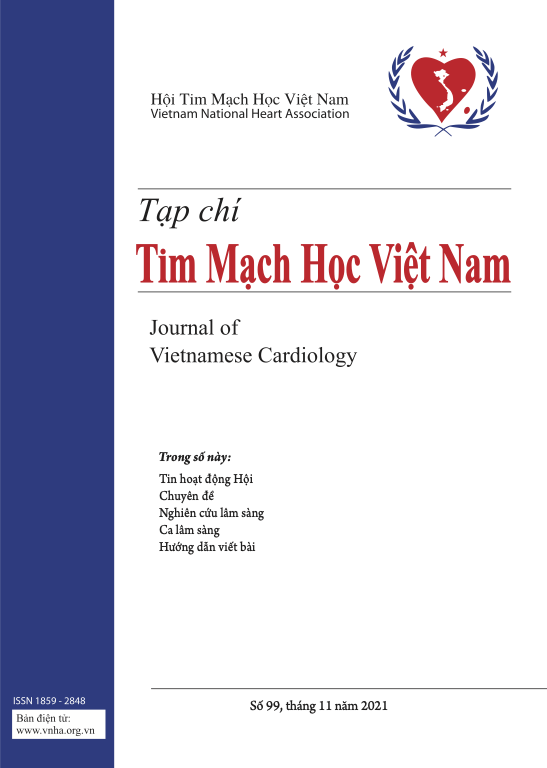Khảo sát mối tương quan giữa sự đề kháng aspirin và sự kiểm soát đường huyết trên bệnh nhân đái tháo đường type 2
Tóm tắt
Đặt vấn đề: Tình trạng đề kháng aspirin ngày càng tăng trên bệnh nhân đái tháo đường (ĐTĐ) type 2. Các nghiên cứu gần đây cho rằng sự kiểm soát đường huyết có thể ảnh hưởng đến sự đề kháng aspirin. Mục tiêu của nghiên cứu này nhằm khảo sát mối tương quan giữa sự kiểm soát đường huyết và sự đề kháng aspirin trên bệnh nhân ĐTĐ type 2.
Phương pháp: Chúng tôi đo sự đề kháng aspirin trên 75 bệnh nhân ĐTĐ type 2 và 75 bệnh nhân không ĐTĐ type 2 bằng hệ thống PFA – 100 (Platelet function analyzer – 100). Sự đề kháng aspirin được xác định khi thời gian lấp kín hoàn toàn lỗ trung tâm collagen/epinephrine (CEPI/CT) ≤ 188 giây. Sự kiểm soát đường huyết được xác định thông qua chỉ số glycated hemoglobin (HbA1c).
Kết quả: Dựa trên số liệu phân tích cho thấy tỷ lệ đề kháng aspirin trên nhóm bệnh nhân ĐTĐ type 2 (22,7%) là cao hơn nhóm không ĐTĐ (14,7%) một cách có ý nghĩa thống kê (p = 0,03). Phân tích về sự tương quan cho thấy sự đề kháng aspirin có tương quan mạnh với HbA1c (r = - 0,94, p = 0,001) và chỉ số khối cơ thể (r = - 0,85, p = 0,001).
Kết luận: Đề kháng aspirin ở bệnh nhân đái tháo đường type 2 cao hơn ở bệnh nhân không đái tháo đường (22,7% so với 14,7%; p = 0,03). Tình trạng đề kháng aspirin có tương quan mạnh với sự kiểm soát đường huyết thông qua chỉ số HbA1c
(r = - 0,94, p = 0,001).
Từ khóa: Đái tháo đường, Glycated hemoglobin, Platelet function analyzer – 100.
Tài liệu tham khảo
1. American Diabetes Association, (Jun 2012), “Standards of Medical Care in Diabete - 2012”, Diabetes Care 35(Suppl 1), p. S11 - S63.
![]()
2. Angiolillo DJ, (2009 Feb 2), “Variability in responsiveness to oral antiplatelet therapy”, Am J Cardiol, 103(3 Suppl), p. 27A-34A.
![]()
3. Crescente M, Di Castelnuovo A, Iacoviello L, de Gaetano G, C Cerletti, (2008 Jun), “PFA-100 closure time to predict cardiovascular events in aspirin-treated cardiovascular patients: a meta-analysis of 19 studies comprising 3,003 patients”, Thromb Haemost, 99(6), p. 1129 - 1131.
![]()
4. Davì G, Gresele P, Violi F, Basili S, Catalano M, Giammarresi C, Volpato R, Nenci GG, Ciabattoni G,
![]()
C. Patrono, (1997), “Diabetes mellitus, hypercholesterolemia, and hypertension but not vascular disease per se are associated with persistent platelet activation in vivo. Evidence derived from the study of peripheral arterial disease.”, Circulation, 96(1), p. 69 - 75.
![]()
5. Ertugrul DT, Tutal E, Yildiz M, Akin O, Yalçin AA, Ure OS, Yilmaz H, Yavuz B, Deveci OS, Ata N, M Küçükazman, (2010 June 1), “Aspirin Resistance Is Associated with Glycemic Control, the Dose of Aspirin, and Obesity in Type 2 Diabetes Mellitus”, The Journal of Clinical Endocrinology & Metabolism, 95(6), p. 2897 - 2900.
![]()
6. Fateh-Moghadam S, Plöckinger U, Cabeza N, Htun P, Reuter T, Ersel S, Gawaz M, Dietz R, W. Bocksch, (2005 Jun), “Prevalence of aspirin resistance in patients with type 2 diabetes”, Acta Diabetol, 42(2), p. 99 - 103.
![]()
7. Gurbel PA, et al, (2007), “Effects of Diabetes on the Prevalence of Aspirin Resistance During Low Dose Aspirin Therapy”, ACC meeting 2007, Abstract, p. 1019 - 1079.
![]()
8. Pignone M, Alberts MJ, Colwell JA, Cushman M, Inzucchi SE, Mukherjee D, Rosenson RS, Williams CD, Wilson PW, MS; Kirkman, Association; American Diabetes, Association; American Heart, Foundation. American College of Cardiology, (2010 Jun), “Aspirin for primary prevention of cardiovascular events in people with diabetes: a position statement of the American Diabetes Association, a scientific statement of the American Heart Association, and an expert consensus document of the American College of Cardiology Foundation.”, Diabetes Care, 33(6), p. 1395-1402.
![]()
9. Watala C, Golanski J, Pluta J, Boncler M, Rozalski M, Luzak B, Kropiwnicka A, J. Drzewoski, (2004), “Reduced sensitivity of platelets from type 2 diabetic patients to acetylsalicylic acid (aspirin)-its relation to metabolic control”, Thromb Res, 113(2), p. 101 - 113.
![]()
10. “Executive Summary: Standards of Medical Care in Diabetes—2009”,(2009), Diabetes Care, 32(Supplement_1), p. S6–S12.
![]()








